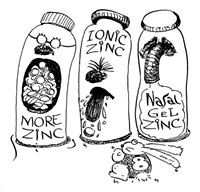OK, Cecil. Sixteen years ago, at the end of a column about whether zinc lozenges cure the common cold, you wrote: "Today you don't hear much about vitamin C as a cold cure. I'll bet you a jumbo box of Contac that the same thing happens to zinc." Did you win the bet? Did you lose? We're left hanging here. —sbunny8, from the Straight Dope Message Board
You were left hanging because I was left hanging—nobody took my bet. Though the zinc vs. colds controversy hasn't petered out altogether, hasn't made much progress, and is nowhere near a firm conclusion one way or another.
But you know me: I like to bring closure to the great questions of our time. While that's not easy in a field as squishy as medicine, I've come up with a methodology to get things off the dime. You've heard of meta-analysis? I take it to the next level: meta-meta-analysis.
Meta-analysis may be crudely described as the study of studies. Meta-meta-analysis is studying studies of studies. Meta-analysis uses sophisticated statistical techniques to tease out conclusions from a confusing mess of data. Meta-meta-analysis is simpler: it relies on eye-rolling, wisecracks and snark.
Enough buildup. Let's get to work.
1. To recap: The claim, first bruited by George Eby in 1984, was that a zinc lozenge held under the tongue would alleviate cold symptoms in as little as two hours. Eby is an interesting individual. He's not a physician, but rather is head of the George Eby Research Institute in Austin, Texas. His home page, at ColdCure.com, displays a GIF of a rippling American flag and a photo of himself holding a bottle of the zinc lozenges he sells. Zinc isn't the only metal he's taken an interest in; he also believes magnesium will cure depression.
2. Despite his lack of marquee cred, Eby and his zinc claims have been taken seriously by the medical-research establishment. By his own reckoning, as of 2010, there had been "14 double-blind, placebo-controlled, randomized clinical trials" of zinc cold cures, which "produced widely differing results with ... one-half showing success and the remainder showing failure."
3. You or I might be discouraged by results like that. Not Eby. He drew a distinction between ionic—that is, chemically reactive—zinc and chemically bound, nonreactive zinc. His conclusion? We'll get to that. First an aside.
4. From what I can make out, the ionic vs. bound business arises largely from a drawback of ionic zinc: It tastes unbelievably gross. (Remember: you're supposed to hold the lozenges under your tongue.) My assistant Una, who has tried them—I assure you, I didn't put her up to this—offers the following testimony: "The kind with ionic zinc taste so dreadful I can't use them due to nausea." To improve the taste, many formulations on the market now bind the zinc to glycine or citric acid. As we'll see, this may not be the best idea.
5. Mere experimentation having proven little, researchers then turned to meta-analysis and other methods of reviewing multiple studies. The idea, to oversimplify: trends not apparent in numerous small studies may jump out when the numbers are viewed in aggregate. Obvious problem: many small piles of crap pushed into one big one don't thereby become research gold. Various techniques are used to winnow junk data, but the outcome can be like the late Bowl Championship Series: you can see what they were going for without necessarily buying the result.
On to those reviews:
6. Caruso et al. (2007) started with 105 zinc studies and pruned them down to 14 that the team deemed scientifically valid. Conclusion: zinc lozenges and nasal sprays did nothing; zinc nasal gel couldn't be ruled out.
7. Back to Eby. Based on his 2010 review of 14 studies (mostly the same ones; you'll recall seven said aye, seven nay), he claimed the deciding factor was the proportion of ionic zinc: the more a given dose had relative to total zinc, the better it fought colds. Eby is (unsurprisingly) big on lozenges, but he thinks the ones using bound zinc, which include most of those currently out there, are worthless. Corollary, based on Una's experience: for zinc to cure what ails you, it has to make you sick.
8. Hemila (2011) looked at 13 of the studies—seven oui, six non. But Hemila proposed his own explanatory variable: the effective zinc preparations had a dose of at least 75 milligrams.
9. Singh & Das (2011) performed what's known as a Cochrane systematic review of 15 studies. They offered no judgments about dosage, formulation or other such minutiae. They just declared (well, not "just"—the Cochrane method is quite rigorous): zinc is effective.
10. Zinc advocates may now chirp: multiple reviews (sorta) agree—zinc (maybe sometimes) works! My meta-meta-conclusion: When reviewers looking at the same basic data come up with three different ideas about the right way to use the stuff (more zinc! ionic zinc! possibly zinc nasal gel!) ... well, let's be charitable. There's plenty of room for doubt.
Send questions to Cecil via StraightDope.com or write him c/o Chicago Reader, 350 N. Orleans, Chicago 60654.
More by Cecil Adams
-
This Is the End, My Friend
This week's Straight Dope marks the last appearance of the column as the Teeming Millions have known it for the past 45 years.
- Jul 11, 2018
-
Do Brain Supplements Do Anything?
Brain Drain
- Jul 4, 2018
-
Is flying really worse for the environment than driving?
Planes and Trains
- Jun 27, 2018
- More »




